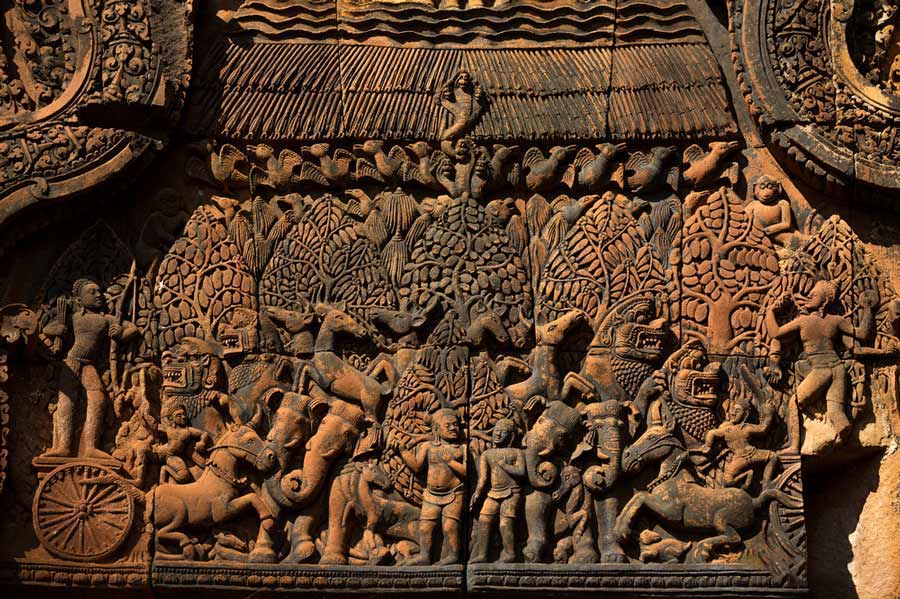Banteay Srei

Banteay Srei is a 10th-century temple complex located in the Angkor Archaeological Park in Siem Reap Province, Cambodia. It is renowned for its intricate and well-preserved decorative carvings, which are considered some of the finest examples of classical Khmer art. The temple is dedicated to the Hindu god Shiva and is sometimes referred to as the "Citadel of Women" or "Citadel of Beauty" due to the delicacy of its carvings.
Banteay Srei is situated about 25 kilometers (15 miles) northeast of the main Angkor Wat complex, making it a popular destination for tourists exploring the Angkor archaeological site. Its remote location and the fact that it was not a royal temple suggest that it may have been built by wealthy courtiers or high-ranking officials of the Khmer Empire.
The temple was rediscovered in the early 20th century and underwent restoration efforts to preserve its unique architectural and artistic features. Today, Banteay Srei stands as a testament to the artistic and architectural achievements of the Khmer civilization during the Angkor period.
Constructed during the 10th century under the rule of King Jayavarman 5, this temple boasts a history spanning almost a millennium. Initially dedicated to the Hindu deity Shiva, the temple gradually faded into obscurity amidst the vast and impressive Angkor complex, concealed in the dense forest due to its remote location. It wasn't until 1914 that a French explorer stumbled upon the hidden gem, and since then, Banteay Srei Temple has gained prominence as a well-known tourist attraction in Cambodia.
The architecture of Banteay Srei is distinctive within the Angkor temple complex and is characterized by its smaller size, intricate detailing, and the use of red sandstone.
Red Sandstone Construction: Banteay Srei is predominantly constructed using red sandstone, which gives the temple a unique and warm hue. This is in contrast to the gray sandstone commonly used in other Angkor temples.

The temple is known for the beauty of its sandstone lintels and pediments.
Compact Size: Compared to some of the larger temples in the Angkor complex, Banteay Srei is relatively small in size. Its compact layout contributes to the intimacy and detailed nature of its carvings.

The temple is smaller in scale provides an intimate and manageable setting
Intricate Carvings: Banteay Srei is renowned for its exceptionally detailed and intricate carvings that cover almost every available surface. The carvings depict scenes from Hindu mythology, including stories of gods, goddesses, and epic narratives.

The carvings cover various architectural elements
Lintels and Pediments: Elaborately carved lintels and pediments adorn the entrances and doorways of Banteay Srei. These feature intricate bas-reliefs depicting mythological and religious scenes.

The lintels and pediments at Banteay Srei provide a rich visual tapestry
Devatas and Apsaras: The temple is adorned with numerous devatas (divine female deities) and apsaras (celestial dancers). These figures are intricately carved into the sandstone, showcasing a high level of craftsmanship.

The devatas and apsaras in the carvings - The religious significance of the temple
The architectural features of Banteay Srei reflect the artistic mastery of the Khmer craftsmen during the Angkor period. The temple's smaller size and the meticulous detailing of its carvings contribute to its reputation as a jewel of Khmer art and architecture.
Transportation
Entrance Fees: A one-day pass to the Angkor Archaeological Park, which includes Banteay Srei, costs $37 USD for foreign visitors. The pass is required to enter the temple complex.
Accommodation: Accommodation costs in Siem Reap can vary widely depending on the type of lodging chosen. Budget hotels and guesthouses may range from $20 to $50 USD per night, while upscale hotels and resorts can be significantly more expensive.
Food: Dining costs can vary based on where you choose to eat. Street food and local markets are generally more budget-friendly, while dining in upscale restaurants can be more expensive. On average, budgeting $10 to $30 USD per day for meals is a reasonable estimate.
The ideal period to explore Banteay Srei and the expansive Angkor region in Cambodia is during the dry season, typically extending from November to March. This time is characterized by dry and cool weather, offering optimal conditions for temple exploration, with daytime temperatures ranging from a mild 20°C to 30°C. The dry season also leads to diminished vegetation, providing clearer views of the temple structures and enhancing the overall photographic experience. It's important to note that this time frame corresponds to the peak tourist season, resulting in larger crowds, particularly in December and January.
For the best experience when visiting ancient temples, it is advisable to plan your visit during the early morning or late afternoon. These hours offer the best opportunities to capture stunning, radiant photos with the ancient temples against a tranquil backdrop. The soft lighting during these times enhances the beauty of the historical sites and provides a more serene and captivating atmosphere.
Banteay Srei Temple is situated just over 20 kilometers from the ancient Angkor complex and a little more than 30 kilometers from the center of Siem Reap. Traveling to this historic temple involves a Tuk Tuk journey through charming villages and expansive rice fields. The entire trip from the city center to the ancient Angkor temples takes approximately 30 minutes.
In recent years, the road leading to Banteay Srei has undergone improvements for better accessibility. The pathway is flanked by carefully planted and renovated rows of green trees. The local government in Siem Reap has acquired and expanded the surrounding area, incorporating the houses where people once lived into the archaeological site.
However, reaching the actual ancient temple requires traversing dense hills. The temple itself is nestled deep within the forest, resembling a secluded island surrounded by grapevines. This natural setting adds to the allure of Banteay Srei, offering visitors a unique and atmospheric journey through the Cambodian landscape